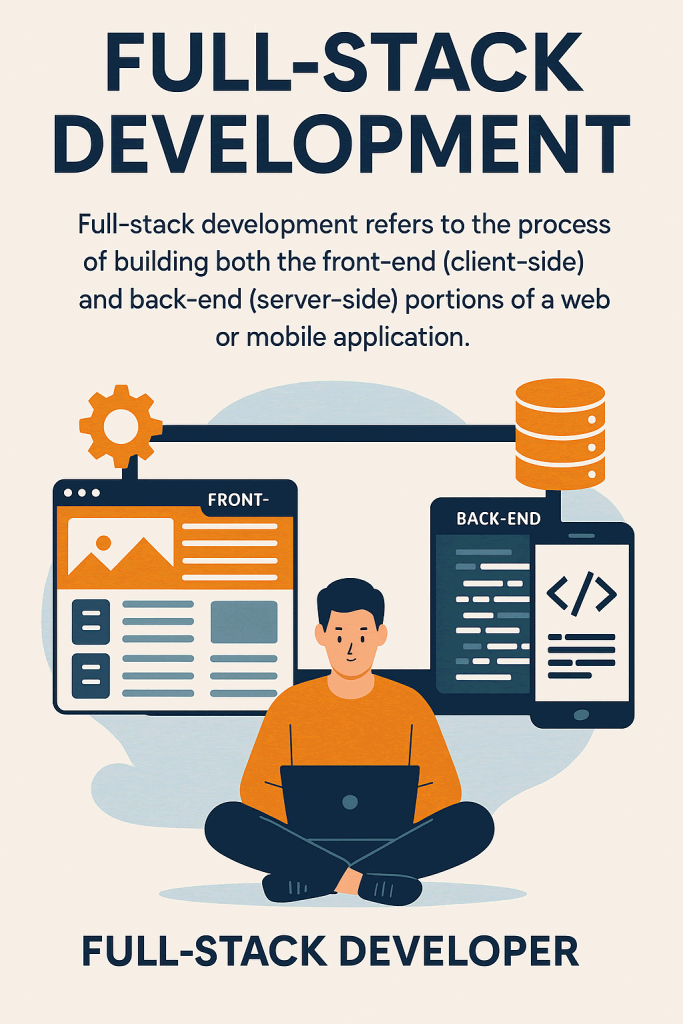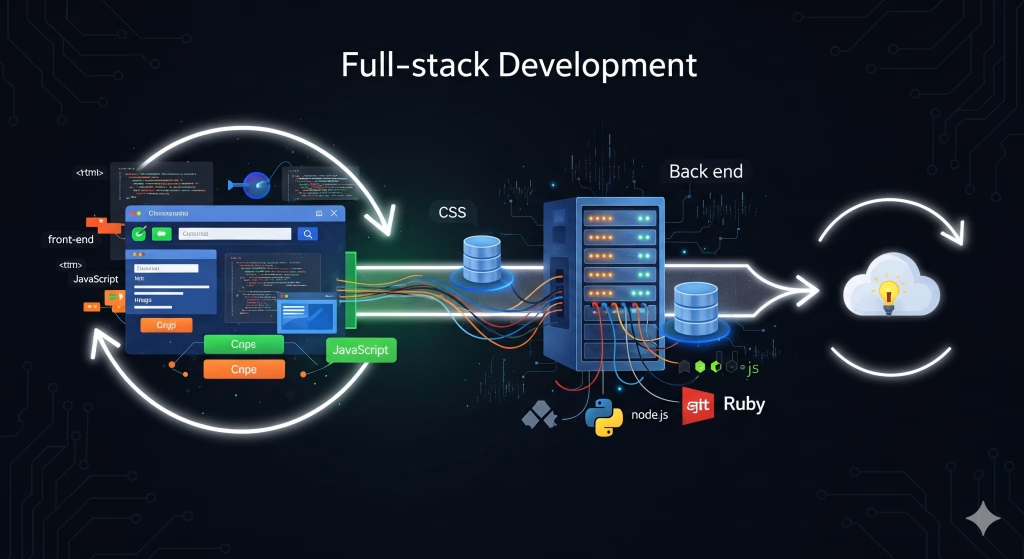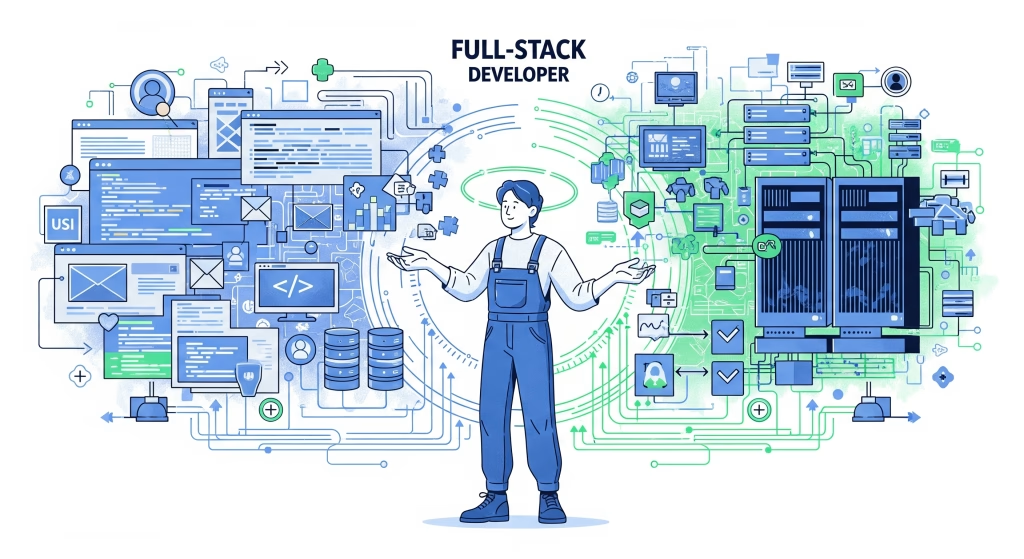
Advantages of Full-Stack Development:
✔ Versatility – Can work on entire projects.
✔ Faster Development – Understands both ends, reducing dependencies.
✔ Better Collaboration – Bridges the gap between front-end and back-end teams.
Popular Full-Stack Tech Stacks:
- MERN Stack: MongoDB, Express.js, React, Node.js
- MEAN Stack: MongoDB, Express.js, Angular, Node.js
- LAMP Stack: Linux, Apache, MySQL, PHP/Python
- Django Stack: Django (Python), PostgreSQL, React/Vue
Components of Full-Stack Development:
- Front-End (Client-Side) Development
- Deals with what users see and interact with.
- Technologies:
- HTML, CSS, JavaScript (core languages)
- Frameworks/Libraries: React, Angular, Vue.js
- Styling: Bootstrap, Tailwind CSS, SASS
- State Management: Redux, Context API
- Back-End (Server-Side) Development
- Handles business logic, database interactions, and server management.
- Technologies:
- Programming Languages: JavaScript (Node.js), Python, Java, Ruby, PHP, C#
- Frameworks: Express (Node.js), Django (Python), Spring Boot (Java), Ruby on Rails
- Databases: SQL (MySQL, PostgreSQL) & NoSQL (MongoDB, Firebase)
- APIs: RESTful APIs, GraphQL
- Authentication: JWT, OAuth
- DevOps & Deployment (Often part of full-stack)
- Manages deployment, cloud services, and CI/CD pipelines.
- Technologies:
- Cloud Platforms: AWS, Azure, Google Cloud
- Containerization: Docker, Kubernetes
- CI/CD: GitHub Actions, Jenkins
Skills Required for a Full-Stack Developer:
- Front-end + Back-end Programming
- Database Management (SQL & NoSQL)
- API Development (REST, GraphQL)
- Version Control (Git, GitHub/GitLab)
- Basic DevOps & Cloud Knowledge
- Problem-Solving & Debugging
MORE LINKS:
What is Backend?
Supported Databases
Data storage methods
API creation
3rd party services
Hosting Setup
Backend developer
Project scaling
Average turnaround
What is full-stack development?
Full-stack development is the process of building both the front-end and back-end parts of a website or application. The front-end covers everything users interact with directly the design, layout, buttons, and overall experience. The back end, on the other hand, handles what happens behind the scenes data storage, server logic, authentication, and integrations with external services. Full-stack development brings these two sides together into a unified, functional product that runs smoothly across all layers.
A full-stack developer is someone who understands how all of these parts work together and can move comfortably between them. They can design the user interface, write the code that powers user interactions, and also build and manage the server-side logic and database systems that support the application. This broad skill set allows them to see the bigger picture, troubleshoot issues across the stack, and build end-to-end solutions that are efficient, scalable, and maintainable.
One of the biggest advantages of full-stack development is flexibility. A single developer or team can take an idea from concept to launch without needing to hand off work between separate front-end and back-end teams. This streamlines communication, reduces delays, and often results in cleaner, more cohesive code. It’s especially useful for startups, small businesses, and agile development environments where speed and adaptability are key.

In today’s digital landscape, full-stack development is more than just a convenience it’s a strategic advantage. It allows for faster iteration, better performance optimization, and tighter integration between design and functionality. Whether you’re building a simple site or a complex platform, full-stack developers offer the technical depth and versatility to bring your vision to life across every layer of the project.
Full stack development is the kind of buzzword that recruiters love to print on job ads, usually without much understanding of what it means in practice. Stripped of hype, it simply refers to a developer who can operate on both the front end and the back end of a system. In other words, someone who builds the interface that users see and also wires it to the logic, databases, and infrastructure that actually make it work. The idea sounds glamorous, but in reality it describes a role stretched across two very different worlds.
On the front end side, the full stack developer handles the visible components. That means dealing with HTML, CSS, and JavaScript frameworks that shape the layout, styling, and interactivity of an application. It requires knowledge of how to present information clearly, make interfaces responsive, and avoid the traps of inconsistent design. This layer is about creating the illusion of simplicity, even as the underlying systems grow more complex.

The back end demands an entirely different skill set. Here the developer works with server side languages, databases, and application logic. It involves structuring data, managing APIs, securing user sessions, and ensuring performance does not collapse under load. Unlike the front end, which is judged instantly by appearance, the back end is invisible until it fails. A crash, a security hole, or an unoptimized query exposes weaknesses brutally and without ceremony.
Bridging these two domains is what supposedly defines a full stack developer. In theory such a person moves seamlessly from writing SQL queries to fixing CSS bugs, from configuring a server to wiring up a payment form. In practice, competence is often uneven. Very few people truly master both ends at a high level. Most full stack developers lean heavily toward one side while being merely adequate on the other, yet the market insists on the label because it suggests efficiency.
The rise of this role is less about technical purity and more about economics. Companies want fewer hires who can cover more ground, even if that breadth comes at the cost of depth. A single full stack developer can keep a small project alive, but larger systems inevitably demand specialists who go deeper into performance, security, or design. The term survives because it sells the idea of versatility in an industry obsessed with cost cutting.
Ultimately full stack development is less a clearly defined discipline and more a shorthand for generalism in software building. It includes front end presentation, back end logic, database management, and often some DevOps tasks on the side. The name flatters, but the reality is a balancing act between competing demands. It can produce flexible problem solvers, or it can produce overextended generalists who do everything halfway. The context decides which version you get.


